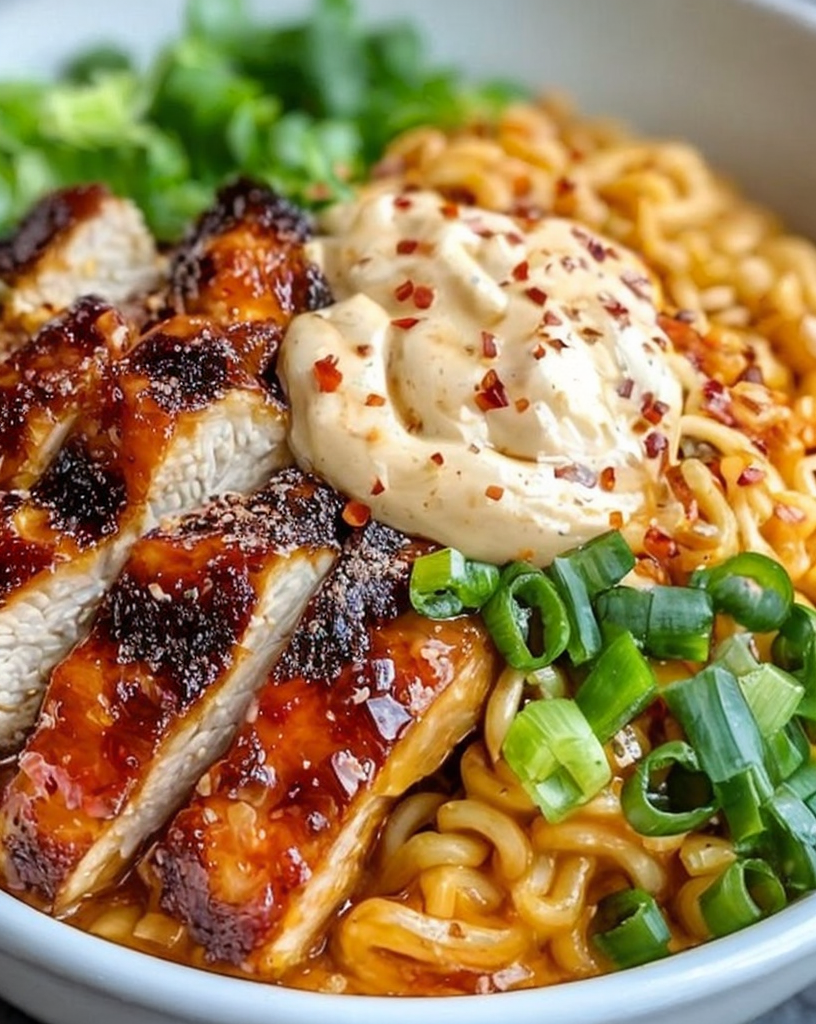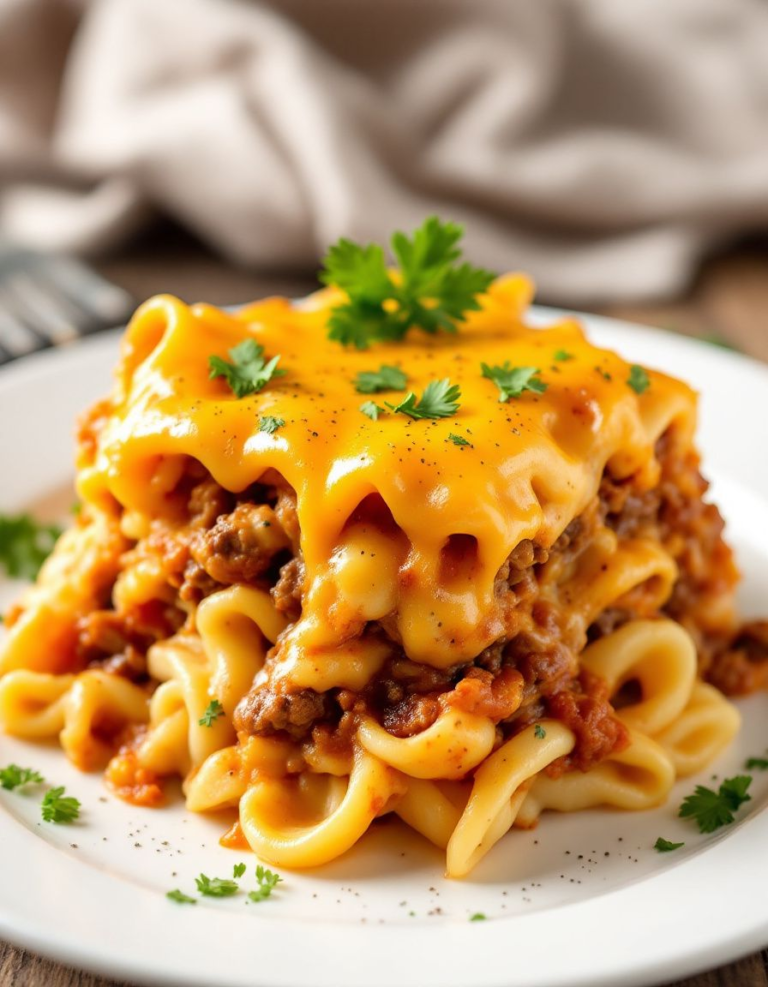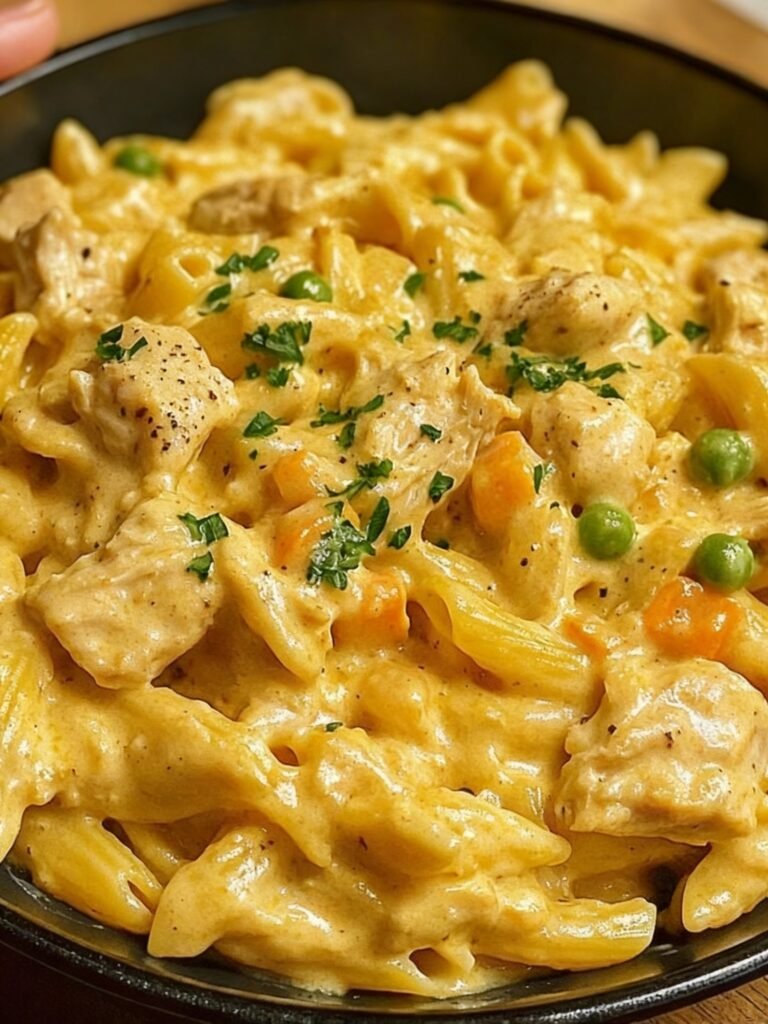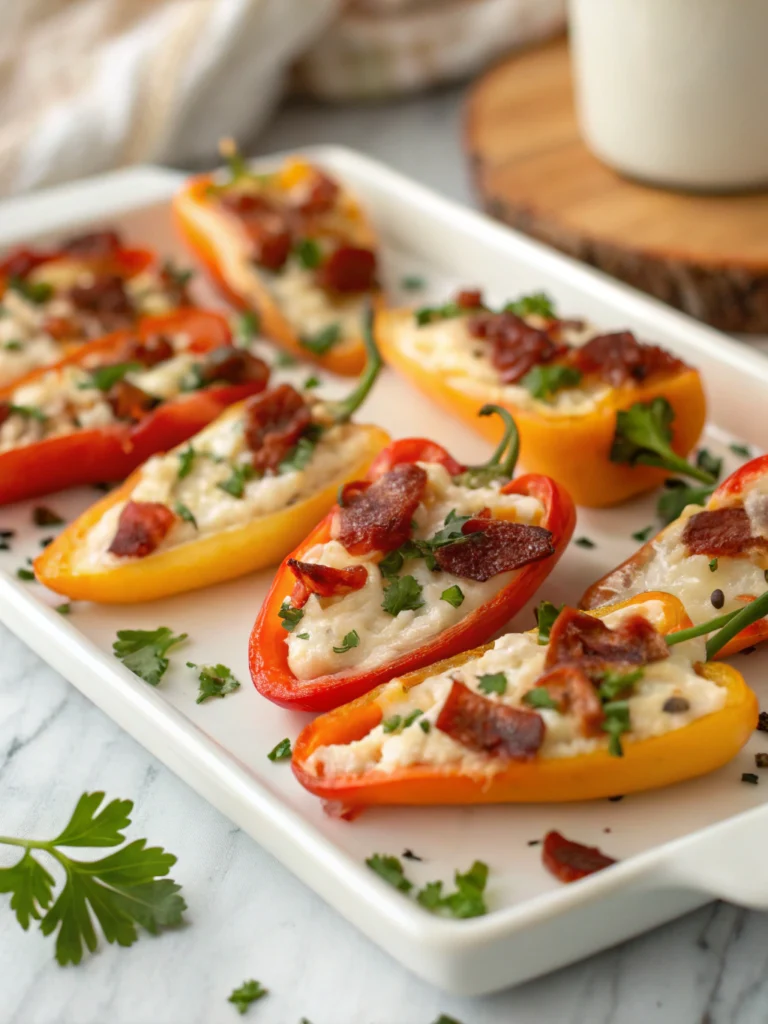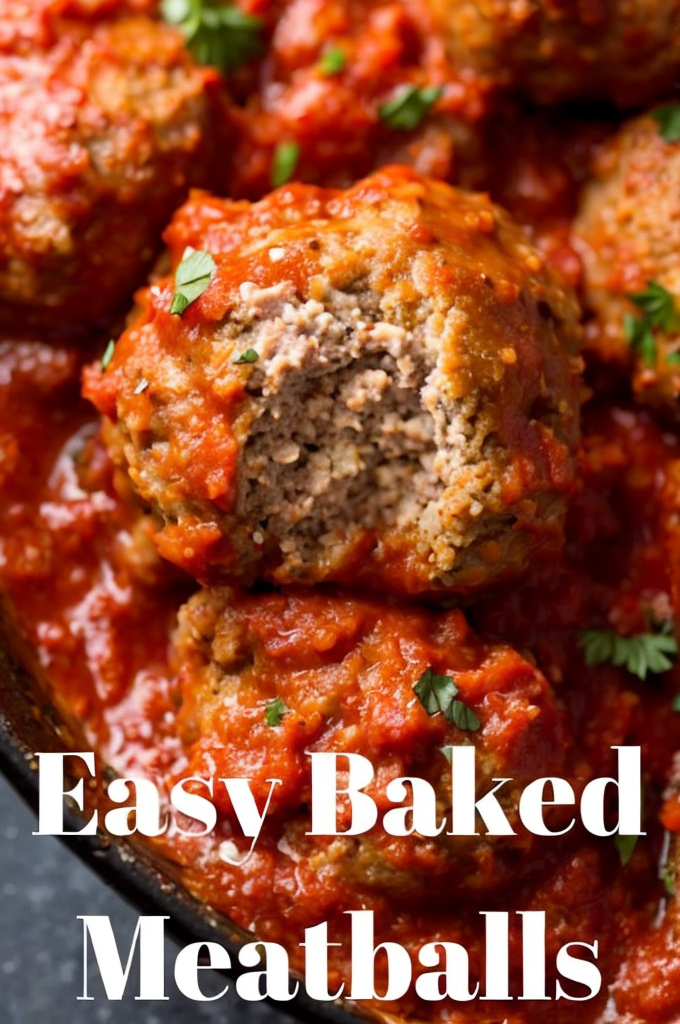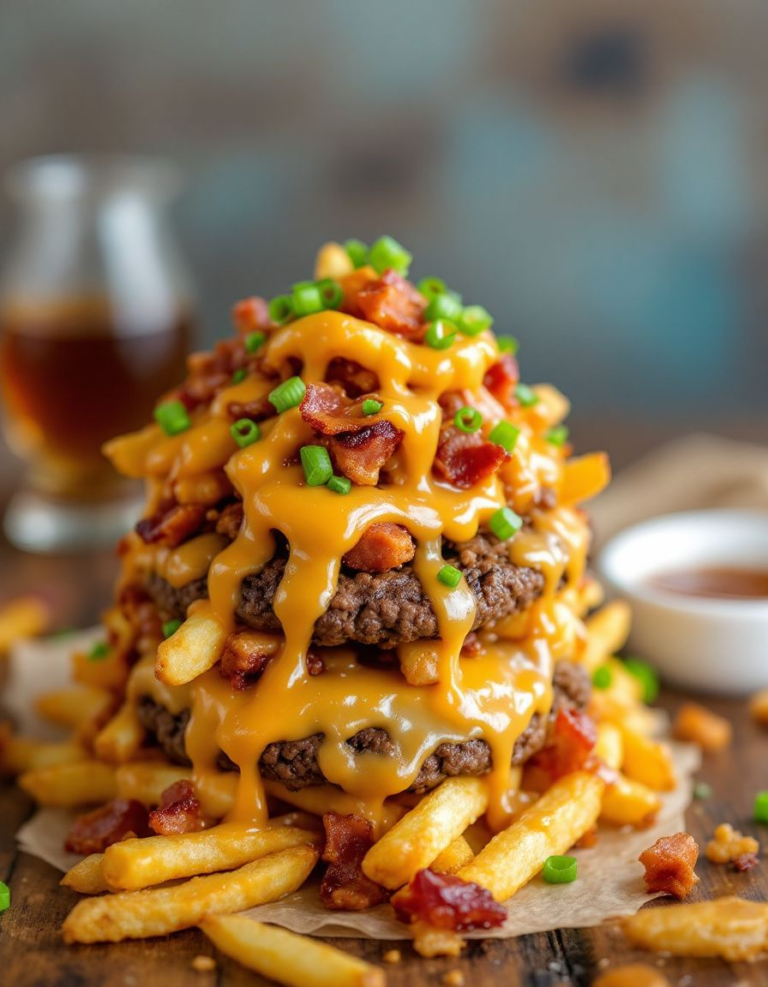Ultimate Spicy Chicken Ramen Bowl with Creamy Sauce Ready in 30 Minutes
Spicy Chicken Ramen Bowl with Creamy Sauce: A Fire-Filled Delight for Your Taste Buds
Spicy Chicken Ramen Bowl with Creamy Sauce is the perfect solution for those seeking a deliciously fiery and satisfying meal. The dish features tender chicken, rich ramen noodles, and a creamy sauce that melds beautifully with the spices to create an explosive flavor. With every slurp of the ramen, you can taste the robust umami combined with the heat of spices, leaving your taste buds tingling and wanting more.
This recipe is highly adaptable, making it easy to customize based on your preferences. Whether you enjoy a spicier kick or want to mellow out the heat, this Spicy Chicken Ramen Bowl can be modified to suit your palate. Not only is it full of bold flavors, but it also delivers on texture—each bowl is filled with creamy sauce that coats the noodles perfectly while providing crunchy garnishes that add an exciting crunch.
Quick Recipe Highlights
- Flavor Profile: Expect a delightful blend of spicy and creamy, with notes of garlic and ginger perfectly balanced by a touch of savory soy sauce.
- Texture: The ramen noodles provide a soft base contrasted by the crunchy vegetables and tender chicken, making each bite a complete experience.
- Aroma: A rich aroma of spices, garlic, and fresh herbs will greet you as the dish cooks, whetting your appetite for the flavorful meal to come.
- Visual Appeal: The vibrant colors of the vegetables against the creamy sauce make this dish visually stunning, perfect for impressing guests.
- Skill Level Needed: This recipe is perfect for intermediate cooks looking to expand their repertoire with bold flavors and multi-step preparation.
- Special Equipment: All you need is a pot for boiling the noodles and a skillet for cooking the chicken and sauce.
Recipe Overview
- Difficulty Level: This recipe involves some basic cooking techniques such as sautéing and boiling, making it accessible for intermediate cooks while still providing room for mastering quick cooking methods.
- Category: This is a perfect meal for lunch or dinner, fitting seamlessly into easy weeknight meals or sophisticated dinner parties.
- Cuisine: The recipe draws inspiration from Japanese ramen, fused with modern culinary techniques to enhance flavor and presentation.
- Cost: The approximate cost per serving is quite reasonable, combining affordable ingredients like chicken, noodles, and vegetables.
- Season: Spicy Chicken Ramen is a fantastic meal for any season but can be especially comforting during colder months.
- Occasion: This dish is ideal for casual dinners, get-togethers, or even meal prep for busy weeks ahead.
Why You’ll Love This Recipe
This Spicy Chicken Ramen Bowl is an explosion of flavors that excite the palate. The balance of heat from the spices and richness from the creamy sauce creates a comforting yet invigorating dish. The use of fresh ingredients, like scallions and cilantro, not only enhances the flavor but also adds a burst of color, making it a feast for the eyes as well.
The convenience of preparing all the elements in one pot significantly reduces cleanup time. You can easily whip this up on a busy weeknight in just about 40 minutes, making it a great choice for quick yet satisfying meals. Prep time is minimized by utilizing store-bought ramen noodles that cook in a flash.
Nutritionally, this dish packs a punch, providing protein from the chicken, fiber from the vegetables, and carbohydrates from the noodles. This balance makes it a filling meal option without excess calories. Each bowl can be enjoyed as a complete meal, integrating macronutrients while also satisfying the soul.
Gathering friends and family for a bowl of Spicy Chicken Ramen creates an opportunity for sharing and enjoying a warm meal together. The hearty nature of ramen makes it ideal for sharing, making your dining experience not just a meal but a social event.
From a cost perspective, the ingredients are readily available and budget-friendly. You can easily substitute any chicken with tofu or seitan for a vegetarian-friendly twist without breaking the bank.
Historical Background and Cultural Significance
Ramen has deep roots in Japanese culture, originating as a comfort food that has become beloved worldwide. The dish was introduced to Japan in the late 19th century, influenced by Chinese noodle dishes. It quickly evolved into various regional interpretations across Japan, each showcasing unique flavors and ingredients.
The cultural importance of ramen goes beyond just being a meal—it’s a symbol of Japanese culinary art, often featured in street food stalls and restaurants across the country. Ramen shops are a common sight in Japan, where patrons enjoy not just the dish itself but the experience of its preparation and serving.
Over the years, ramen has evolved significantly, becoming a canvas for culinary creativity. Today, you can find countless variations of ramen that deviate from the traditional chicken broth base, including spicy miso and curry-flavored broths that reflect the region’s evolving taste preferences.
Regional variations are widespread; for instance, tonkotsu ramen from Kumamoto is known for its rich pork bone broth, while Hokkaido is famous for its buttery corn and miso ramen. Each variant highlights local ingredients, techniques, and flavors, showcasing the diversity and richness of Japanese ramen culture.
Ingredient Deep Dive
– Chicken: A primary source of protein, chicken has been a dietary staple across many cultures. It plays a crucial role in this recipe, providing essential nutrients while soaking up the spicy and creamy sauce effectively. When selecting chicken, choose cuts that offer both flavor and tenderness, and remember to store it properly to maintain freshness.
– Ramen Noodles: Traditionally, ramen is paired with alkaline noodles which add a unique texture. These noodles are often made from wheat and are quick to cook. When buying ramen, opt for fresh or dried varieties based on availability. If you have leftovers, store them in an airtight container to maintain their texture, and consider quick rehydration in boiling water before serving.
– Creamy Sauce Ingredients: Typically made from a base of sesame paste or nut butter, these ingredients add a rich and velvety texture to your ramen dish. The creaminess balances the heat, providing a well-rounded flavor profile. For a healthier alternative, consider using yogurt or reduced-fat options, ensuring that you maintain the dish’s integrity with respect to flavor and texture.
Common Mistakes to Avoid
- Overcooking the noodles: Following cooking time strictly is vital to avoid mushy noodles. Always check your noodles a minute before the suggested boiling time.
- Using low-quality chicken: Investing in quality chicken can drastically improve the flavor and texture of your dish, leading to more enjoyable meals.
- Missing the seasoning: Seasoning your broth and sauce adequately is crucial; taste as you cook to adjust flavors accordingly.
- Skipping garnishes: Fresh toppings like scallions and cilantro lift the dish and add refreshing contrasts to the rich flavors.
- Not letting the sauce thicken: Allow the sauce to reduce properly for desired creaminess. A high heat helps create that rich consistency.
- Neglecting to balance flavors: A well-rounded dish needs the right balance of spice, creaminess, and salt; taste-testing at each step is essential.
- Inadequate prep: Prepare all ingredients before starting to cook to avoid rushed steps and to maintain organized cooking.
- Improper storage: Ensure you store leftovers in an airtight container to maintain freshness, preventing spoilage.
- Ignoring ingredient quality: Fresh ingredients significantly enhance the taste, so always select the best possible produce for this dish.
- Poor serving temperature: Ramen should be served hot. If serving at a later time, heat it through on the stove instead of the microwave for the best texture.
Essential Techniques
– Mastering the sauté: A crucial technique, sautéing allows flavors to develop by browning ingredients before adding liquids. It’s essential for building a rich foundation for your broth and sauce. Watch for the color transformation, indicating readiness.
– Cooking noodles correctly: Follow specific package instructions for perfectly cooked noodles. The ideal noodle should be al dente, providing a good bite without being overly soft.
– Creating a saucy blend: Balancing your sauce to achieve the desired consistency is vital. Start with lower heat and gradually thicken by simmering, which helps avoid clumping or separation.
Pro Tips for Perfect Spicy Chicken Ramen Bowl
– Incorporate a splash of lime juice before serving to brighten the overall taste and enhance the spicy notes.
– Experiment with different types of noodles, like udon or soba, for varied textures.
– To save time, consider marinating the chicken the night before for deeper flavor absorption.
– Adding a drizzle of sesame oil enhances the dish’s aroma and flavor complexity.
– For an extra layer of spice, include a spoonful of chili paste or sauce during the cooking process.
– Use vegetable or chicken stock instead of water for a more flavorful broth.
– Garnish with pickled ginger or roasted sesame seeds for an added crunch and brightness.
– Don’t shy away from experimenting with additional proteins like shrimp or tofu to customize the dish.
Variations and Adaptations
– Regional variations can be incorporated by adding local spices or ingredients. For example, replace the chicken with miso-infused tofu for a unique twist.
– Seasonal adaptations can include using vegetables available in your garden, adjusting the recipe based on what’s freshest.
– Dietary modifications can be made easily: substitute gluten-free noodles or choose a vegan protein, like chickpeas, to cater to different dietary needs.
– Flavor variations, such as adding coconut milk for a creamy texture, can transform this dish into a tropical delight.
– Texture modifications with the addition of roasted vegetables can introduce a delightful crunch to your bowl.
– Presentation alternatives may involve serving in a traditional ramen bowl topped with garnishes that add color and height to elevate the visual appeal.
Serving and Presentation Guide
– For plating, consider a deep bowl that showcases the noodles while allowing for a generous portion of broth and toppings.
– Garnish with fresh herbs, a drizzle of chili oil, and a sprinkle of toasted sesame seeds. This not only enhances flavor but elevates presentation.
– Traditional accompaniments might include pickled vegetables or soft-boiled eggs for richness.
– Modern serving suggestions allow for creative elements such as roasted veggies, giving your ramen a contemporary twist.
– Temperature considerations are vital; serve hot and ensure ingredients are warmed up before assembling the bowl.
– Portion control tips involve serving modest amounts of noodles topped with a generous amount of broth, ensuring balanced servings for everyone.
Wine and Beverage Pairing
– Pair this Spicy Chicken Ramen with a chilled Riesling, its sweetness balancing the heat perfectly.
– Non-alcoholic alternatives can include sparkling water infused with citrus for a refreshing contrast.
– If you prefer coffee pairings, consider a light roast that complements the noodles without overwhelming the dish.
– Temperature considerations for beverages should align with serving temperatures for food; chilled drinks with hot ramen make a delightful contrast.
– Serving suggestions can include providing small tasting glasses with various pairings to enhance the meal experience.
Storage and Shelf Life
– Store leftovers in an airtight container in the refrigerator for 3-4 days. Ensure to separate the broth and noodles to prevent sogginess.
– Maintain temperature requirements by allowing ingredients to cool before sealing to avoid condensation.
– Utilize glass or BPA-free containers for safe storage, and remember to label items with dates for freshness tracking.
– Signs of spoilage include sour smells or discoloration; when in doubt, discard the leftover dish.
– Reheat on the stovetop for an even temperature distribution, adding a splash of water or broth to refresh the noodles.
– Freezing guidelines suggest portioning out noodles and broth separately when storing for over a month.
Make Ahead Strategies
– A solid prep timeline can involve marinating chicken the night before and chopping veggies in advance to waAMing up your cooking process.
– Storage between steps may include keeping vegetables in a sealed container to preserve freshness and flavor until you’re ready to cook.
– Quality impact assessment reveals that pre-cooked ingredients don’t lose much flavor, especially when sealed properly.
– Assembly tips can include keeping the broth hot while the noodles cook for best texture retention.
– When reheating, add fresh elements like green onions or herbs to preserve vibrancy.
– Fresh element additions, such as serving with freshly sliced avocado, elevate the dish to new nutritional heights.
Scaling Instructions
– Halving the recipe works well; simply adjust ingredient measurements while maintaining the same cooking times.
– Doubling or tripling the recipe is also feasible if you have a large enough pot, allowing for family gatherings or meal prep for the week.
– Equipment adjustments may include selecting a larger pot or skillet to accommodate increased ingredient quantities.
– Timing modifications will likely remain similar, but keep a close eye on the cooking elements to prevent overcooking.
– Storage considerations should involve equally portioning leftovers into individual servings for easy access throughout the week.
Nutritional Deep Dive
– The macro breakdown reveals a balanced composition of carbohydrates, protein, and fats, creating an energy-dense meal.
– Micronutrient analysis shows the inclusion of vitamins and minerals from the vegetables, ensuring a healthy meal option.
– Highlighting the health benefits, the lean protein and fresh veggies contribute to muscle repair and immune support.
– Dietary considerations can include adjusting serving sizes for specific dietary goals, making it versatile for various lifestyles.
– Portion analysis suggests a well-rounded bowl serves as an ideal meal, focusing on satiety and nutritional balance.
– For weight management tips, consider reducing noodle portions while increasing veggie content for a low-calorie yet filling dish.
Dietary Adaptations
– For a gluten-free option, substitute traditional ramen noodles with rice noodles or gluten-free pasta.
– A dairy-free adaptation can involve omitting the creamy elements, using coconut milk instead for rich texture.
– Vegan variations can incorporate tofu or chickpeas to maintain protein content without animal products.
– Low-carb options can replace noodles with zucchini noodles or cauliflower rice for a lighter meal.
– For paleo enthusiasts, forgo the soy sauce and utilize natural flavors from fresh herbs and spices.
– Low-FODMAP variations can be achieved by using specific vegetable selections that meet dietary restrictions.
The Recipe
Spicy Chicken Ramen Bowl with Creamy Sauce
Serves: 4
Prep Time: 15 mins
Cook Time: 25 mins
Total Time: 40 mins
Kitchen Equipment Needed
- Large pot for boiling noodles
- Skillet for cooking chicken and sauce
- Knife for chopping
- Cutting board
Ingredients
- 2 boneless, skinless chicken breasts, diced
- 4 servings of ramen noodles
- 2 cups chicken broth
- 1 cup heavy cream or coconut milk
- 2 tablespoons soy sauce
- 1 tablespoon chili paste or sriracha (adjust to taste)
- 1 tablespoon sesame oil
- 2 scallions, chopped
- 1 cup sliced bell peppers
- Fresh cilantro for garnish
Directions
- In a large pot, bring water to a boil and cook the ramen noodles according to package instructions. Drain and set aside.
- In a skillet, heat sesame oil over medium heat. Add diced chicken and sauté until golden brown and cooked through, about 5-7 minutes.
- Add the sliced bell peppers and cook for 2-3 minutes until they begin to soften.
- Pour in the chicken broth, heavy cream, soy sauce, and chili paste. Stir well and bring to a simmer.
- Let the sauce thicken for about 10 minutes, stirring occasionally. Taste and adjust seasoning as necessary.
- Combine cooked ramen noodles into the skillet with the sauce, tossing to coat evenly.
- Serve hot, garnished with chopped scallions and cilantro.
Recipe Notes
- For a vegetarian option, substitute chicken with tofu and increase the vegetable content.
- Adjust spice levels according to your preference by modifying the amount of chili paste.
- Create a lighter version by using half-and-half instead of heavy cream.
Troubleshooting Guide
– For overly salty broth: Balance it out with more unsalted chicken broth or water, allowing flavors to merge.
– If noodles become too soft: Reduce cooking time, and consider rinsing in cold water after cooking to halt cooking.
– Flavor too bland: Enhance umami by adding additional soy sauce or miso to deepen the savory profile.
– Sauce too thick: If the sauce is thicker than desired, whisk in a little warm water or broth to loosen.
– Chicken is dry: This can happen if cooked for too long; ensure the chicken reaches a safe internal temperature but remains juicy.
– Too spicy: Introduce more cream to mellow out the spice levels without losing flavor depth.
– Veggies that are too crunchy: If vegetables remain uncooked for your taste, sauté them a little longer at the beginning.
– For undercooked chicken: Increase cooking time, ensuring chicken reaches the correct internal temperature.
– If the presentation lacks vibrance: Add colorful garnishes to enhance visual appeal and reflect balance in flavors.
– Off-putting texture: Ensure you’re using fresh ingredients to maintain optimal texture throughout the dish.
Recipe Success Stories
The community feedback on this Spicy Chicken Ramen Bowl has been overwhelmingly positive. Many have shared their version of the recipe, highlighting how easy it is to customize with seasonal vegetables or substitute the protein based on personal preferences. Successes include using roasted Brussels sprouts creating novel texture and flavor profiles.
Readers have also mentioned adapting the heat levels to their liking, making the recipe versatile for all spice enthusiasts. Social media users frequently share stunning photographs of their bowls, showcasing the vibrant colors of the toppings that reflect the meal’s appeal.
Anecdotes of family gatherings around a bubbling pot of ramen have been endearing, showcasing the dish’s ability to bring people together. Photos of unique garnishing techniques have sparked creativity, encouraging others to elevate their plating skills.
The recipe has not only made its way into home kitchens but has become a staple for dinner parties, with guests requesting seconds. Photography tips shared by readers on lighting and angles have further enhanced the appeal of this dish on social platforms.
Frequently Asked Questions
Can I make this dish vegan?
Absolutely! You can easily make this Spicy Chicken Ramen Bowl vegan by substituting the chicken with tofu and using a plant-based cream alternative. Additionally, adjust the broth to ensure it’s meat-free.
What type of ramen noodles should I use?
You can use any ramen noodles, whether fresh or dried. Aim for wheat-based noodles for an authentic taste, but feel free to substitute with rice noodles for gluten-free options.
Can I prepare the sauce ahead of time?
Yes, the sauce can be made ahead of time. Store it in an airtight container in the refrigerator for up to three days. Reheat gently before serving with the cooked ramen noodles.
What can I add for extra flavor?
For added flavor, consider incorporating miso paste, garlic, or ginger when sautéing the chicken. Additionally, lime juice can add brightness to the overall dish.
Is this recipe adjustable for spice levels?
Definitely! You can adjust the level of spice by varying the amount of chili paste or sriracha you use. You can also add sliced jalapeños as a garnish for an extra kick.
How can I enhance the texture of the dish?
Enhance texture by adding crispy toppings like fried shallots or crushed peanuts for a delightful crunch. Roasted vegetables can also introduce contrasting textures.
What sides pair well with this ramen?
Serve alongside a simple side salad or spring rolls for a complete meal. These lighter dishes will complement the decadent flavors of the ramen bowl.
Can I freeze leftovers?
Yes, you can freeze leftovers, but it’s best to separate the noodles from the broth before freezing to maintain their texture. Store components in separate containers for up to 2 months.
How can I increase the nutritional content?
Add extra greens like spinach or bok choy to the broth while simmering. This not only enhances nutrition but also enriches colors and flavors in your ramen.
What if I have leftover toppings?
Leftover toppings can be used on other dishes or added to salads for a flavorful boost. Store toppings separately to maintain freshness and texture.
Additional Resources
For those interested in exploring more about ramen, consider checking out related recipes that use similar techniques or flavors. Whether it’s a savory miso ramen or a spicy variant, integrating various styles of ramen can lead to a broader understanding of this beloved dish.
Technique guides on how to prepare fresh noodles, handle seasoning, and garnish effectively can elevate your cooking to another level. Understanding the cultural significance of ramen can add depth to your appreciation of this dish and its place in culinary history.
Equipment recommendations are essential for first-time cooks; having the right tools can simplify the cooking process and enhance the quality of your meals. Exploring seasonal variations can keep your cooking fresh and interesting, as well as connect you to local ingredients available at different times of the year.
Join the Conversation
Engage with the community by sharing your cooking experiences and variations of the Spicy Chicken Ramen Bowl. Whether it’s through social media or recipe blogs, sharing photographs and personal stories adds richness to the culinary journey.
Photography tips can be valuable for friends looking to share their culinary creations; small adjustments to lighting, angles, and background settings can significantly enhance visual appeal in photos.
Recipe reviews can provide constructive feedback and encourage new cooks, fostering engagement and building a supportive cooking community. Celebrate your creativity with others, and don’t hesitate to swap tips on additional variations that make this dish your own. Sharing your experiences helps to inspire and connect with fellow food enthusiasts.

